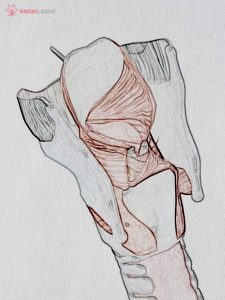The intrinsic laryngeal muscles are responsible for controlling sound production.
- Cricothiroyd muscle lengthen and tense the vocal folds.
- Posterior Cricoarytenoid muscles abduct and externally rotate the arytenoid cartilages, resulting in abducted vocal folds.
- Lateral Cricoarytenoid muscles adduct and internally rotate the arytenoid cartilages, increase medial compression.
- Transverse arytenoid muscles (Arytenoideus) adduct the arytenoid cartilages, resulting in adducted vocal folds.
- Oblique arytenoid muscles (Arytenoideus) narrow the laryngeal inlet by constricting the distance between the arytenoid cartilages.
- Thyroarytenoid muscles (sphincters of vestibule), narrow the laryngeal inlet, shorten the vocal folds, and lower voice pitch. The internal thyroarytenoid is the portion of the Thyroarytenoid that vibrates to produce sound.
Notably the only muscle capable of separating the vocal cords for normal breathing is the Posterior Cricoarytenoid. If this muscle is incapacitated on both sides, the inability to pull the vocal folds apart (abduct) will cause difficulty breathing. Bilateral injury to the recurrent laryngeal nerve would cause this condition. It is also worth noting that all muscles are innervated by the recurrent laryngeal branch of the vagus except the Cricothiroyd muscle, which is innervated by the external laryngeal branch of the superior laryngeal nerve (a branch of the vagus).
The Aryepiglottic muscle together with the Transverse arytenoid (Arytenoideus) and the Thyroarytenoid work as a sphincter and close the larynx as we swallow or cough.

